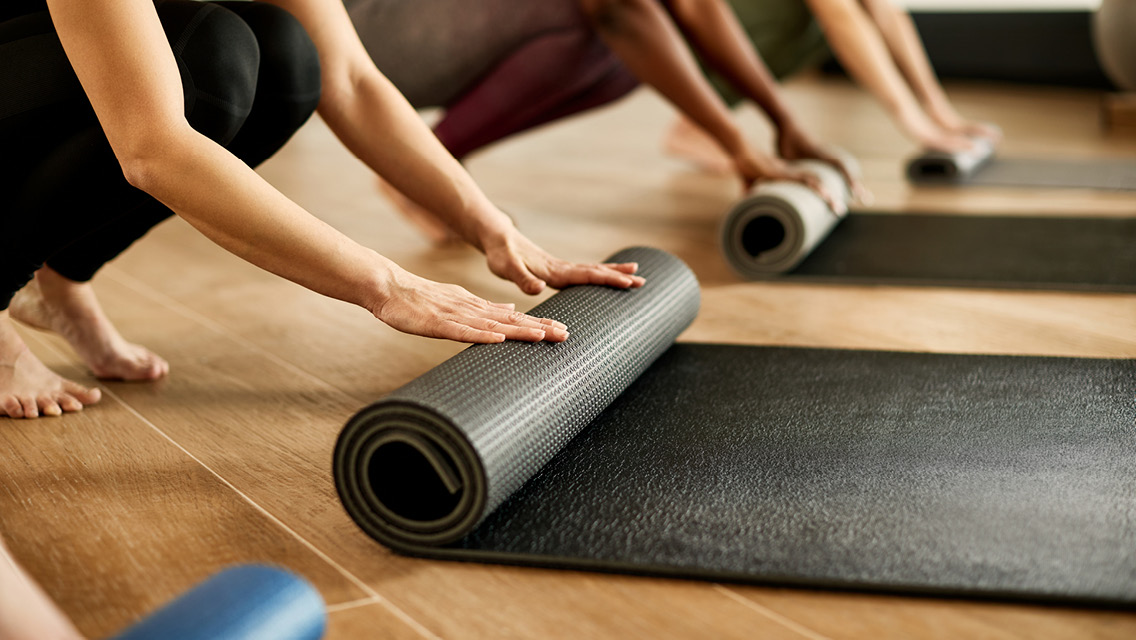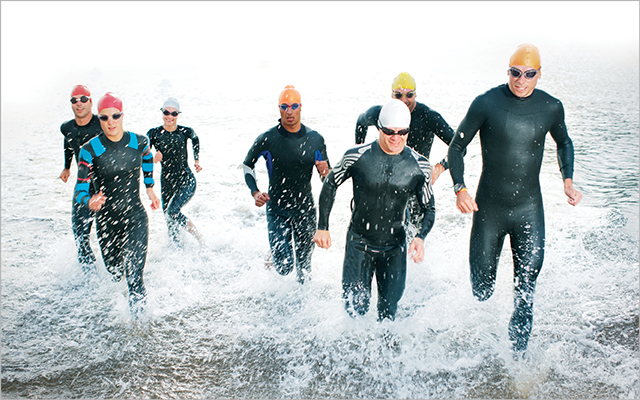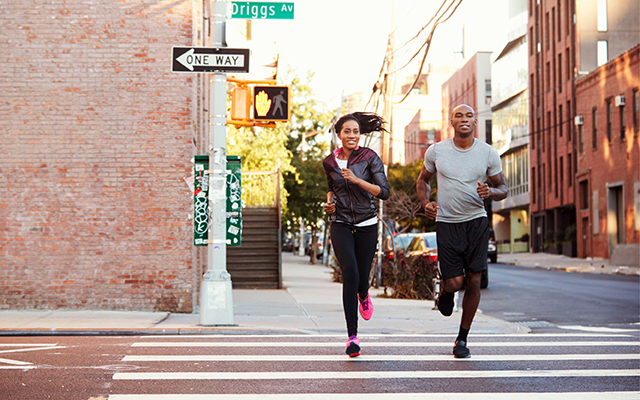Think about the places you go when you need support, community, friendship, encouragement or an energy boost.
Is a fitness class on your list? It very well could be.
Group exercise has come a long way since the days of step aerobics and leg warmers. In the ’80s, group fitness emphasized music, fashion and highly choreographed movements, recalls Tanja Djelevic, MS, a health coach and personal trainer based in Los Angeles who has worked with the likes of Uma Thurman, Jennifer Garner and Kate Beckinsale. “While it was good for getting people moving, it did little to address the mind-body connection of exercise,” she says. Now we understand more about how physical activity stimulates the brain’s emotional center and affects overall wellness. Today, the best classes foster camaraderie, stress relief and emotional intimacy, in addition to an effective workout. The best instructors know that to keep people coming back, they need to nurture not just the body, but the mind and spirit, too.
Jean Fain, LICSW, MSW, a Harvard Medical School–affiliated psychotherapist and author of The Self-Compassion Diet: A Step-by-Step Program to Lose Weight with Loving-Kindness, has studied the physical and emotional benefits of social support and exercise. She explains that what group fitness offers that solo training doesn’t is something she calls “common humanity.”
Walking into a class, having people smile at you, groove to the same music, perform the same exercises and sweat alongside you can instantly make you feel less alone in the world, she says. “This is the realization that you don’t have to tackle life’s challenges alone.”
This kind of camaraderie also has real fitness benefits. “Research shows people are more successful at reaching their fitness goals with group support,” says Fain. They also have fewer major health problems overall, she notes. Psychologically, social exercise also leads to a greater sense of well-being, better self-esteem, improved body image and less depression.
“People aren’t looking to just show up to the gym, sweat and leave,” says Kathy Flaminio, founder of 1000 Petals, a St. Paul, Minn.–based wellness company that offers classes that combine yoga and guided meditation with cycling. Based on her 23 years of fitness industry experience, she’s found that many also want exercise to meet bigger, often unspoken needs in their lives: friendship, nurturing, community, accountability and discipline.
That’s why Flaminio deliberately creates a warm, accepting atmosphere that fosters new friendships, and why she actively cultivates the kind of social support that extends far beyond the gym’s front doors.
“After my Saturday cycling class, many of the members go across the street for tea and coffee,” she says. “They also show up for important events in each other’s lives, from mourning losses to celebrating milestones.”
That kind of group reinforcement is becoming more common at gyms nationwide, it seems. In its “Top 10 Fitness Trends for 2011” report, the American Council on Exercise listed group fitness programs such as boot camps and Zumba as one of the top trends in exercise. The reason? These groups offer increased potential for success, thanks to peer encouragement, fun, community and, in many cases, a holistic approach.
If that’s not enough to get you on the bandwagon, consider this: A supportive, engaging class can actually alter your brain chemistry. Research shows that both social interaction and vigorous exercise increase the activity of neurotransmitters that positively affect mood, attention span, perception and motivation, all of which increase your willingness to go back week after week.
Finding the Right Class
To reap all these benefits, of course, you first have to join a class. And that means finding a program that will give you the most mind-body bang for your buck. The most enjoyable — and thus wildly popular — classes all have a few important traits in common, but personal taste is also a huge factor, so be prepared to shop around until you find the right class for you. Here are the four top factors you’ll want to watch for:
1. An Inspiring Instructor
The first key ingredient in the recipe for a great class is undoubtedly a superb leader-instructor, because he or she will naturally foster all the other factors that make a great class and attract the kinds of participants that make the magic happen. But what makes for an über-instructor? Skills, style, spirit — and perhaps most important, a knack for intuiting your needs.
Teresa Mees, 41, of Columbia, Mo., looks for someone who “teaches and challenges her class with an open heart.” Two years ago, Mees was diagnosed with multiple sclerosis. An active mother of three boys, she says the diagnosis broke her spirit. “Even though I was miserable,” she says, “I fought hard. I thought that was the right thing to do. I hit the gym, though my cardio activities were limited by balance problems and numbness. I told myself and everyone else that MS wasn’t going to hold me down. But in retrospect, I was in a mental state where the only thing that was truly going to make me happy was not having the disease, and since there is no cure, that wasn’t going to happen.”
Then one day a friend took Mees to a power yoga class taught by Gretchen Chudy at a nearby health club. “That hour honestly changed my life,” she says. “As we progressed through class, Gretchen gently cued us through vinyasas and into poses, and was also very careful to remind us to find our own limits and explore our own bodies’ strengths and weaknesses.”
At the end, Chudy encouraged her class to not criticize themselves and their bodies for what they couldn’t do, but to be grateful for the amazing things they could do. “I remember very distinctly that, as I sat on my mat in tears, she urged us to honor our bodies as they are,” Mees says. “That became my intention: to honor my body for what it is. I don’t think I’ve fought the disease or myself for a minute since then.”
For other people, a good instructor is someone who dishes out a little tough love. That’s the case for Carlan Johnson, 31, of Milwaukee, Wis. A former rugby player and college basketball player, Johnson was looking for something more challenging than the typical cardio class. Her search led her to Sara Bayer, who operates the Bayer Performance Institute Boot Camp. “When I first went to the boot camp, I admit I thought briefly that maybe it was going to be too easy,” she says. “Oh boy, did I eat those thoughts!”
Bayer managed to tailor the class to address everyone’s fitness level through exercise modifications. She simultaneously pushed and encouraged participants, creating a safe atmosphere for exploring limits, says Johnson. “It takes a certain finesse to master being tough on people while simultaneously seeming thoughtful and caring,” she says.
No matter their approach, good instructors put a lot of time and emotional investment into their clients. And there are ways to tell how much they care, says Flaminio: “Showing up early and staying late. Offering a blog, videos, Web site or newsletter to keep people connected. Making it easy for members to find them and ask questions.” These aren’t requirements at most gyms, she notes, but they are the kind of extra touches that keep folks coming back for more.
2. A Feel-Good Vibe
Whether it’s high-voltage (Zumba, Salsa Funk, boot camp) or more meditative (yoga, Nia, Pilates), a great class will have a force or transformative energy that grabs you — outwardly or inwardly — and holds your attention.
Karen Kupsco-Vacco, 52, attends a Salsa Funk class at Life Time Fitness in Schaumburg, Ill., and says the unique vibe hits her the moment she walks in the door: “Students enter a darkened room, pulsating with music, and the release of the day’s stress begins. When the instructor, Donna, hops up on stage, we all prepare for the roles we will play for the next hour. She reminds us that after the day at the office or with household matters, dealing with life’s stressors is over and that we are, for the next hour, dancers.”
The class is packed, but that only serves to heighten the energy, says Kupsco-Vacco. “You’d think it would be claustrophobic, but it really adds to the excitement and movement.” The music, crowd and dim lights prevent her from feeling self-conscious about her dancing, she says. “Donna also consistently guides students who are unsure of themselves and can’t see the stage well to watch others around them, saying, ‘We have a lot of talent in here!’ We’ll all stand up a little straighter and smile a bit, wondering if she’s talking about us.”
A similar dynamic occurs in more low-key, restorative classes, too, notes Djelevic. “For a lot of people, that 60 minutes of class time is the only ‘me’ time they get in a single day,” she says. “It provides a stage for people to focus solely on themselves, their body, to love and care for themselves.”
Flaminio agrees. “My class members tell me they’re getting a two-for-one in this hour — exercise and therapy.” She uses guided meditation to facilitate that stress relief. After some brief introductions and small talk at the beginning of class, she dims the lights, turns on music, and invites the class to reflect inward and work on progressive breathing. While her students cycle, Flaminio asks them to contemplate any obstacles they’re facing in their lives at the moment. “I think the bike is a metaphor for life,” she says. “When we lean into the hills instead of resisting them, it’s easier to climb and then enjoy the relief and joy of coasting down the other side.”
Rochelle (last name withheld) was a student in Flaminio’s class during a particularly stressful time in her life — she’d returned to school to pursue a degree after a long absence. The class helped her learn how to move forward when things got uncomfortable, to set goals and focus on the positive aspects of her life. “Whenever I doubted my abilities or felt insecure, I would attend a cycling class, and afterward I regained my confidence and was able to move through it.”
3. Tight Community
Another key to success is a sense of togetherness — the friendship, support, familiar faces and accountability that come from your classmates.
Typically, it’s the instructor who fosters this sense of community. “People can get more out of their classes if the instructor creates the space for safety, acceptance and interaction,” Flaminio explains. “I do this by arriving early, offering towels sprayed with essential oils like peppermint or lavender, introducing myself to new members, checking in and seeing what’s happening in their lives.” When she started making these efforts, Flaminio noticed that class members began showing up to class earlier and earlier just to have that interaction with her and with each other. Eventually, the connections continued after class, too.
Of course, no instructor can foster team spirit all on his or her own. “The community atmosphere is created by the trainers and the class members,” says Jason C. Brown, co-owner of Urban Athlete, a kettlebell and boot-camp studio in Philadelphia that attracts seasoned athletes and fitness newbies alike. “It’s the little things, like making people feel comfortable and welcome, and class veterans helping newcomers learn the moves,” says Brown. “There’s no ego here. We have class members who are 55 and obese working out and laughing right alongside chiseled athletes.”
Having members shadow and interact with one another makes classes less intimidating, he says, and friendships flourish: “We have a couple who met in one of our classes, started dating and eventually got married. They still attend classes together.”
Keep in mind that the community mood will probably take its cues from the class itself. Boot-camp classes might tend toward the jocular, while yoga classes foster a more namasté-inspired sort of interaction.
4. A Super Workout
The best classes push you to work out harder than you do alone or by following along with a video at home.
There are a couple of reasons for this, explains Brown. The music, energy and enthusiasm of the instructor are infectious and cause you to give more. Meanwhile, fellow classmates help elevate your workout, too. It’s a subtle form of peer pressure: “You know that others may be watching, and you step it up.” Plus, the group setting can spark a feeling of friendly competition.
“Everyone who starts a new fitness routine is looking to be motivated and inspired, to start a fire inside of themselves, to work hard and get results,” personal trainer Tanya Djelevic says. “It’s often hard to do that alone.” Whether it’s the tough-love accountability of a boot-camp instructor or the gentle nudge of a friend who noticed you missed the last cycling class, the best classes make you want to keep coming back.
Top-notch classes also offer functional, full-body routines that accomplish a lot in a short time frame. Ian Richer, 35, a new-media creative director in Los Angeles, joined CATZ Sports Performance two years ago simply to get access to weight-training equipment, but now says he’s happy he stumbled upon the group classes offered there. “In 60 minutes, we cover it all,” Richer says. “We start with circuit training that involves stairs and medicine balls, then do two or three more strength-training sets.” Richer, who had a strong fitness base even before attending CATZ, says he was pushed by the hardcore routines.
Likewise, at health clubs nationwide, there’s been a surge in cardio-strength offerings, or classes that combine yoga, cycling and other functional-fitness regimens.
Alex Bradley, 38, of Louisville, Colo., says she loves the efficient, functional workout that her Yogalates (a yoga-Pilates hybrid) class provides. The class addresses her need for a tough workout, and the physical and emotional balance she needs as the mother of a young child. “Having other people around motivates me to work hard,” she says. “And after a day of parenting my toddler, having guidance for how to connect my body and mind is essential.”
Meet Your Fitness Match
- If you crave simplicity, camaraderie, or prefer a natural ebb and flow to your exercise, try cycling, swimming, or yoga.
- If you are extroverted and love to be entertained while you sweat, try Zumba, BODYJAM, Modern Dance Workout, Jazzercise or Nia.
- If you like weightlifting and pushing yourself to your limits, try Boot camp, kettlebell or BODYPUMP.
- If you are introverted and crave a quiet, meditative, yet effective workout, try yoga, tai chi, Pilates or mind-body cycling.
Find a Class
Word of mouth is often the best way to find a quality fitness group in your area, so start by asking around. But keep in mind that what works for your best friend may not work for you, says Jean Fain, LICSW, MSW, a Harvard Medical School–affiliated psychotherapist and author of The Self-Compassion Diet: A Step-by-Step Program to Lose Weight with Loving-Kindness. Consider the following:
- Your personal preferences and priorities. “A good question to ask yourself is ‘How do I want to feel during the class?’” says Fain. “Are you looking for a tough-love, drill-sergeant-type atmosphere? Or do you want to be nurtured — mind, body and soul?”
- Next, look at the who/what/when/where facts of the classes being offered. If you’re not sure just by reading the description, call the studio or the class instructor and ask for specifics about the skill level, the content of the class and the demographics of the class members.
- Ask to read some testimonials or evaluations. Most health clubs and exercise studios elicit constructive feedback from their members. Take a look at how others rate the class, and you’ll get a better idea of the quality. If no evaluations are available, ask the front desk which classes tend to be the most popular among members like you.
- Seek, don’t settle. “If you attend a class once and don’t like the vibe or don’t think the type of workout is what you’re looking for, don’t feel like you have to go back,” says Fain. Test drive different instructors and formats. “Keep looking until you find the class that’s the right match for you.
The Essentials
Make the most of whatever class you choose by coming prepared with:
- A towel and water bottle
- Appropriate shoes (street shoes track in dirt, so bring clean ones)
- A yoga mat, heart-rate monitor or other equipment not provided
- Cash for the café or juice bar, in case you want to socialize afterward
- A workout journal to log your progress and to jot down phone numbers or class times
This article originally appeared as “Group Effort” in the May 2011 issue of Experience Life.




This Post Has 0 Comments